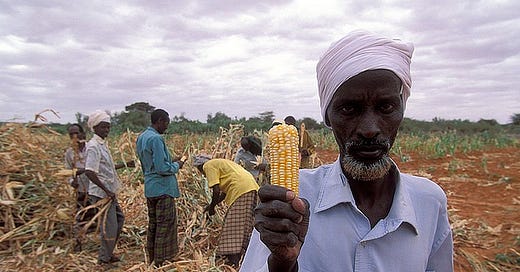Risks to Food Security Severely Underestimated
345 million people facing acute food insecurity today
Surprisingly, food and agricultural policy experts have seriously underestimated the impacts of the rapidly changing climatic and biophysical conditions on global food production.
Need-to-Know: 345 million people suffer from severe hunger
The number of people facing acute food insecurity has soared to 345 million this year compared to only 135 million in 2019, according to the World Food Program. Acute food insecurity is hunger so severe that it poses an immediate threat to people’s livelihoods and lives.
Food security has become increasingly challenging due to extreme weather, water scarcity, plateauing crop yields, soil degradation, and declining arable land. The war in Ukraine and trade disruptions have added to this.
Need-to-Know: 500 million babies will be born in next 7 years
And consider that the global population is expected to increase from 8.0 billlion to 8.5 billion by 2030.
Meeting the enormous challenge of feeding the world requires, among other things, reliable projections of crop production so policies and resources can be effectively allocated.
The vast majority of recent reports, studies, and crop production models only incorporate changes like temperature, precipitation, and CO2 levels. That’s led to an over-optimistic confidence in our ability to feed ourselves in the coming years, according to an analysis from Harvard University.
This approach omits a much broader suite of other potent global scale environmental changes that are affecting agricultural productivity.
Need-to-Know: There are increasing threats to agriculture
Here are a few of the changes missing in those rosy future-food production projections:
Extreme events like floods and droughts, and the fact they are increasing in frequency and severity.
Declines in pollinating insects. This is already limiting the yields of fruits, vegetables, nuts, and legumes.
Greater heat in a warming climate decreases crop yields by damaging pollen grains. That prevents fertilization, reduces plant growth, and increases mortality. For example, a 1-degree-C increase in temperatures reduces rice, wheat, and maize crop yields in India, Brazil, sub-Saharan Africa, and other less-developed countries.
Livestock also suffer under heat stress which decreases fertility, weight gain, and milk and egg production.
Higher CO2 levels may increase growth in some crops but can also reduce their nutrient levels.
Increased pest and disease prevalence.
The impacts of biodiversity losses, including declines in pest predators, and in microorganisms are essential in maintaining soil fertility.
Fisheries declines as fish populations move towards the poles to avoid hotter ocean temperatures in the tropics. (See NtK: Have We Reached Peak Fish?)
Salinization of water tables caused by sea level rise
Most of these excluded factors can have anywhere from a modest to severe negative impact on agricultural production.
Need-to-Know: The world’s breadbaskets at risk in next decade
The very latest crop models show substantial climate impacts coming well before 2040 in major breadbasket regions. And that’s without accounting for all of the biophysical changes, some of which are impossible to model.
We’ve had a preview of what the impacts can be after last year’s extreme weather affected food production in Europe, the U.S., China, Pakistan, and elsewhere. It is a significant factor in why 345 million people are facing acute food insecurity today.
Need-to-Know: Agricultural emissions need to fall nearly 40%
Agriculture is not only highly vulnerable to the impacts of climate change but is also a major source of greenhouse gas emissions. Agricultural emissions need to fall nearly 40% to help keep warming below 2 degrees C while finding a way to feed the world’s growing population, according to The Breakthrough Agenda Report.
To make this happen, public and private investment and policies are urgently needed to:
Reduce food waste;
Limit emissions from livestock and fertilizers;
Consume less meat and improve alternative proteins;
Develop climate-resilient crops and livestock;
Protect soil and water resources while cutting emissions with regenerative agricultural practices.
Feeding the world today, and in the future, while reducing agriculture’s large carbon footprint, is a major challenge. A big part of that challenge is acknowledging the entire food production chain, and the economic system on which its based, is untenable. Failure to change this will only bring more hunger and conflict. Luckily, we know what to do.
Until next time, be safe.
Stephen
Welcome to Need to Know: Science & Insight, my personal newsletter that looks at what we Need-to-Know at this time of pandemic, climate emergency and unraveling of nature’s life supports




